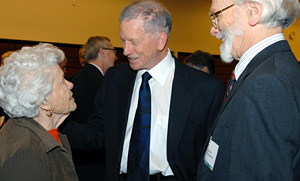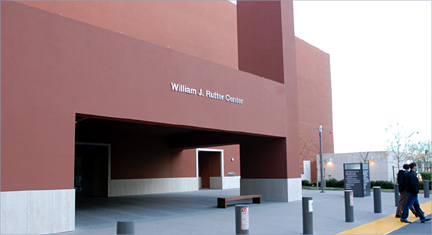
William Rutter
By Jeffrey Norris
"Hippocrates Meets Silicon Valley." What better topic could there be for last Thursday's symposium honoring William J. Rutter, PhD, the man who did the most to transform UCSF into a renowned academic research center and a molecular biology powerhouse who then proceeded to co-found Chiron Corp., part of the strong foundation of today's global biotech industry?
In the San Francisco Bay Area, where scientists determined to see groundbreaking research applied outside the lab fomented commercial revolutions in both computer science and biotechnology, the intersection of the two now is spawning vibrant new ventures.
In a homage coinciding with the Nov. 29 symposium at UCSF Mission Bay, the community center itself -- an open, colorful and distinctive structure designed by world-famous Mexican architects Ricardo and Victor Legorreta -- has been bestowed with a new name. It's now the William J. Rutter Center.
Independent Living for the Aging
Eric Dishman, PhD, global director of Health Research & Innovation at Intel Corp., was among the symposium speakers who shared a glimpse into this marriage of information technology and medicine.
Dishman, trained as a social scientist, has led teams that logged many hours with the aged in their homes to identify special needs that are common among them, with the aim of inventing technologies to meet these needs. The goal is to allow patients to maintain health and to continue living independently or with caregivers, managing conditions such as diabetes, Alzheimer's and Parkinson's.
For instance, Dishman's Intel group is developing behavior-monitoring technologies to capture changes in everyday patterns that may point to the onset or a worsening of Alzheimer's disease. In addition, Dishman's team is working on technologies to help the afflicted cope. Many Alzheimer's patients, for instance, are embarrassed when they cannot immediately recognize people, which can lead to their not responding to the phone, the doorbell or email.
The researchers have confirmed that the elderly are generally willing to use computers and the Internet if they can benefit. Dishman is leading the development and testing of computer-based prompts to help memory-impaired elderly maintain social connections. He described one such tool as "caller ID on steroids."
Better Tumor Treatment in Real Time
Laura Esserman, MD, MBA, UCSF professor of surgery and radiology and director of the Carol Franc Buck Breast Care Center, described National Cancer Institute-sponsored clinical trials in which advances in data collection and in the management of laboratory, imaging and clinical data have permitted unprecedented coordination among large teams of researchers at academic medical centers across the country. New ways to analyze the data generated also are shedding new insight into how different types of breast cancer respond to different treatments.
The capability of using imaging and genetic data to quickly gauge whether individual tumors respond to drugs or radiation has the potential to change medical practice by influencing the choice and sequential order of chemotherapy, radiation and surgery, according to Esserman. The goal is to "tailor therapy at the outset," she said.
Esserman and her clinical research collaborators are working with the National Cancer Institute and the Food and Drug Administration to plan a clinical trial in which treatment for individuals can be changed during the course of the study, depending on how well patients respond to the chosen therapy.
World of Viruses on a Chip
Progress in medicine often seems slow in comparison with the pace of advances in the speed and power of information-processing technologies. But gene sequencing is one area of biomedical research that is making computer industry-like gains.
 |
Francis Larragueta, who helped recruit the biotech pioneer to UCSF in 1969, talks with William Rutter and Chancellor Mike Bishop at the Nov. 29 symposium honoring the biotech pioneer. |
UCSF's Joe DeRisi, PhD, is one of the creators of the "microarray" technology now deployed in labs throughout the world. DeRisi, earlier used microarrays - slides upon which bits of reference DNA are printed and compared to sequences of genetic code present in biological samples - to genetically define the SARS virus as a member of the coronavirus family. DeRisi detected the SARS virus within 24 hours of receiving a sample from the Centers for Disease Control and Prevention. His lab and the lab of UCSF virologist Don Ganem, MD, Phd have teamed up to develop and regularly update the ViroChip, an array containing the most informative DNA from every known virus.
DeRisi and colleagues have used the ViroChip and novel computer programs to sleuth previously unknown or rarely encountered viruses among the acutely sick, and to better chart virus taxonomy.
With the declining cost of DNA sequencing and testing, a version of the ViroChip that yields reproducible results in clinical labs as well as experimental labs could serve as a broad-based test to identify pathogens in cases where the microbial suspect is not obvious, DeRisi said. Even when there is no treatment, finding a viral cause for a respiratory ailment, for instance, might lead to fewer inappropriate prescriptions for antibiotics, which are only effective for bacterial infections.
We know little about the viruses we coexist with day to day, DeRisi reminded the audience. "It is within our technological abilities to look at those things," he said.
What's on Your 23 Pairs of Chromosomes?
Advances in the speed and economy of genotyping also have made possible ventures such as 23andMe, a Mountain View-based company that offers curious consumers willing to provide a saliva sample insight into their own DNA -- including information about their ancestry, their genetic similarities to friends and family who also use the service, and their genetic variations that affect their risks for certain chronic diseases -- for $1,000.
Some may recall that the first comprehensive sequencing of the DNA on all three 23 pairs of human chromosomes - the successful goal of the Human Genome Project - cost $3 billion. Symposium speaker Darren Platt, MD, senior director of research at 23andMe, estimated that the cost has now dropped to a few hundred thousand dollars.
But 23andMe and essentially all users of microarrays take a shortcut. They zoom in on a half million or a million key sites of genetic variation within the genome. These sites have been defined and mapped, and they are detectable with commercial microarray "chips" available through companies such as Illumina, which supplies 23andMe.
Platt raised the intriguing possibility that information provided by those who use the services of 23andMe - if enough people do use it -- could lead to new discoveries linking genes to human traits. Platt said the venture fosters greater interest in and better understanding of genetics and its relationship to human health risks and to similarities and differences among individuals.
Monitoring and Metrics
Symposium speaker Matt Sanders, PhD, is chief executive officer at iMetrikus, a Rutter-founded company that specializes in interactive health management and remote patient monitoring. iMetrikus has developed tools for patients with chronic health problems including diabetes, asthma, chronic obstructive pulmonary disease, heart disease and obesity, that also are useful for their caregivers. Patients can use their own personal health record to gauge what their condition is likely to be on a given day and to receive alerts and reminders. Caregivers can be alerted to the need to intervene with patients in a timely manner.
 |
The community center at UCSF Mission Bay has been named the William J. Rutter Center. |
Ultimately, analysis of the collected data from large patient populations can aid health insurers and health policymakers, according to Sanders.
Companies market many versions of various monitoring devices, Sanders notes, and iMetrikus provides "an agnostic, open-information gateway that collects information from virtually any device that has a port available. Our goal is to see how many devices we can touch." Devices include blood glucose monitors, insulin pumps, blood pressure monitors, spirometers, pedometers and scales.
As an example, Sanders described a project with the Whittier Institute for Diabetes
in which, at a cost of $100 per individual per year, blood sugar management was improved among diabetic individuals living in a low-income Latino community in San Diego County with poor access to health care services. A device plugged into a phone line was used to send data from blood glucose meters to a monitoring nurse at a command-and-control center, who decided when intervention was required. The nurse called a community "matron" to have the matron contact patients and explain in Spanish what actions needed to be taken.
Rutter Legacy Honored
Rutter was recruited to UCSF to transform the Department of Biochemistry and Biophysics. Beginning in 1968 and continuing to 1982, he did so with great energy and insight, filling dozens of new faculty positions with new talent skilled in developing and mastering the latest knowledge of and techniques for probing how molecules drive the biochemical processes governing health and disease.
A recipient of the UCSF Medal as well as other honors and awards, Rutter remained a researcher foremost. His laboratory team demonstrated that an uncontaminated source of material for a hepatitis B vaccine could be obtained by mass producing viral proteins in genetically engineered, laboratory-grown yeast. This was the groundwork leading to the first marketed genetically engineered vaccine, made by Chiron.
Rutter still is a leading force in the high-tech Bay Area business community, and has played an instrumental role in UCSF's successful establishment of the Mission Bay campus, where the community center was the site of Thursday's symposium, moderated by Moira Gunn, PhD, host of NPR's
Tech Nation and Biotech Nation. Paul Otellini, president and chief executive officer of Intel, was the keynote speaker at a dinner following the symposium.
Photos by Christine Jegan
Related Links:
UCSF to name building after biotech pioneer Bill RutterSan Francisco Chronicle, Nov. 29, 2007
Photos by Christine Jegan


